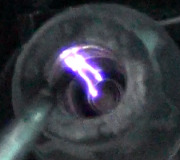12.2 volts means the battery is run down, and you have less than that. Charge it at a slow rate for at least an hour, so the rest of the tests can be trusted. A good, fully-charged battery will measure 12.6 volts.
Once you are done, get the electrical tape out of there too. That will unravel into a gooey mess on a hot day. The best way to prevent moisture from causing future problems from corrosion is to seal the wire with heat-shrink tubing with hot-melt glue inside. When that is not practical, the silicone sealant is the next best thing.
They had you unplug the red/blue wire at the starter relay so you could do testing in the circuit without cranking the engine, but it looks like that may have introduced a new clue. The twelve volts on that circuit feeds the starter relay and the TFI module. 7.4 volts there is not enough to make the starter relay engage, at least not nearly as strongly as normal.
The other problem is you are starting with a drained battery, and its voltage is going to be drawn down even more when cranking the engine to try to get it to start. If you only have 7.4 volts now, it will be less when the starter is working, and that is most likely the cause of the no-spark. Keep that wire unplugged from the starter relay, then measure the voltage on that wire when you turn the ignition switch to "crank". Also, remeasure at the red/blue wire at the TFI module. If you find anything less than full battery voltage while in the "crank" position, we'll have to work our way backward through the neutral safety switch, clutch interlock switch jumper wire, ignition switch, and all the associated wires and connector terminals to see where the voltage is dropping.
If the voltage is still low, as in near 7.4 volts, check it again after unplugging the TFI module. If that makes the voltage jump back up to around twelve volts, plug in the starter relay and listen if that sounds loud and healthy. I prefer to disconnect the large cable that goes to the starter motor so I can listen to the clunk of the relay without it being drowned out by the sound of the starter. You should hear a nice loud single clunk each time the ignition switch is turned to the "crank" position, but do not hold it there very long. The relay will overheat and start to smoke after about a minute, and that can cause the coil inside to warp and become permanently damaged. Do not ask me how I know that.
If you are not sure if the relay is nice and strong, measure the voltage on the red/blue wire at the unplugged TFI module. If you find close to twelve volts, but it drops to 7.4 volts when plugged in, that module is likely shorted and is drawing the voltage down.
Saturday, February 3rd, 2018 AT 2:00 PM



